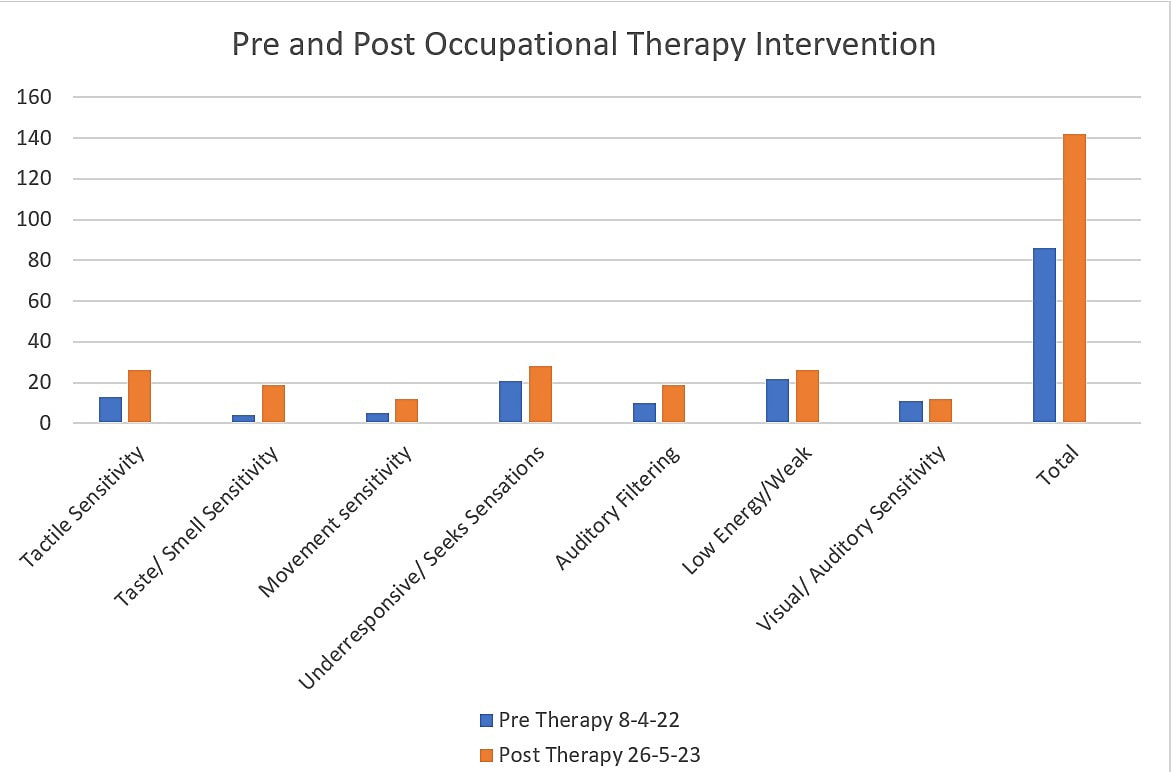
Efficacy of Online Occupational Therapy in the management of Autism: A Case Study
Efficacy of Online Occupational Therapy in the Management of Autism Spectrum Disorder
‘’Autism spectrum disorder (ASD) is a developmental disability caused by differences in the brain. People with ASD often have problems with social communication and interaction, and restricted or repetitive behaviors or interests. People with ASD may also have different ways of learning, moving, or paying attention. It is important to note that some people without ASD might also have some of these symptoms. But for people with ASD, these characteristics can make life very challenging.’’ The occupational therapist (OT) first evaluates the child’s strengths and weaknesses and conducts an interview with the parents to determine their goals for the therapy. Based on this assessment, the therapist designs a personalized therapy plan for the child, which incorporates play-based activities aimed at improving the child’s motor skills, sensory processing, social skills, and cognition.
Sensory Processing difficulties in Autism cause differences in movement needs, ability to adapt to a surrounding, accept changes in routine, textures and tastes tolerance in food, specific and rigid preferences in clothing are few observable changes.
These sensations are perceived as under-stimulatory or over stimulatory resulting in a movement seeking or movement avoidance, respectively.
This presentation affects the performance in areas like a child’s bonding with caregivers and peers, their ability in self-care, scholastic demands and Play.
Clinical Insight into Intervention Journey of the client with us:
Participant: 3years 10 month old child with Moderate to severe Autism was assessed and started with Occupational Therapy Tele rehab intervention.
Method
This child was assessed on sensory profile at 3.10 years and later at 4 years 11 months.
His parents answered the sensory profile and clinical observations were documented by the therapist.
Upon evaluation of clinical presentation, evaluation, informal observation and sensory profile, Occupational Therapy Intervention was recommended and started. The Child attended Online Intervention for 13 months, twice a week initially and later once a week. This data was utilized for this study. The child was mostly regular during this intervention period.
Sensory Integrative Approach, Sensory Motor approach and Play were primary approaches utilized.
Result:
Following are the pre and post-therapy scores comparison:
|
|
Pre-Therapy |
Post Therapy |
|
Tactile Sensitivity |
Definite Difference |
Definite Difference |
|
Taste/ Smell Sensitivity |
Definite Difference |
Typical Performance |
|
Movement Sensitivity |
Definite Difference |
Probable Difference |
|
Underresponsive/ Seeks Sensation |
Probable Difference |
Typical Performance |
|
Auditory Filtering |
Definite Difference |
Definite Difference |
|
Low Energy/ Weak |
Definite Difference |
Typical Performance |
|
Visual/ Auditory Sensitivity |
Definite Difference |
Definite Difference |
|
Total |
Definite Difference |
Probable difference |
Comparative Chart:
29.47% increase in total score on The Sensory Profile was noted, post-therapy, indicative of improved sensory processing ability in this child.
Interpretation:
The Child displayed improvement in Food exploration, good mastication and also acceptance of a variety of tastes and textures.
He seemed more energetic and displayed improved postures in sitting and standing post-therapy.
His movement-seeking had considerably improved, and he participated better in Parent-led activities with least/ nil resistance. His initiation in motor tasks is still low.
Even in Visual/ Auditory Sensitivity, which had the least improvement, the child was observed to regulate and adapt to brighter light inputs or loud sustained noises like a grinder or vacuum cleaner by covering their eyes/ears, instead of crying as earlier.
Auditory Filtering shows least integrative changes and the child responds after 2-3 repetitions of commands.
Discussion and Conclusion:
According to WHO, ‘It is estimated that worldwide about 1 in 100 children has autism (1). This estimate represents an average figure and reported prevalence varies substantially across studies.29-Mar-2023. It’s the same According to ‘The Print’ in India
The prevalence of Autism is suspected to be more than this prediction—early assessment and diagnosis. Screen Related Infantile Autism is another leading Autism sub-type.
Identifying the sensory processing difficulties and early intervention to remediate these difficulties facilitate faster integration. Helping this subject with their motor, sensory, social and play development, have proved to help him adapt and interact better.
Book your session now
- Efficacy of Online Occupational Therapy in the management of Autism: A Case Study - July 21, 2023
- Occupational Therapy Skills at Home - July 15, 2023
- Occupational Therapy for Toddlers with Developmental Delays - June 13, 2023


Leave a Comment
(0 Comments)